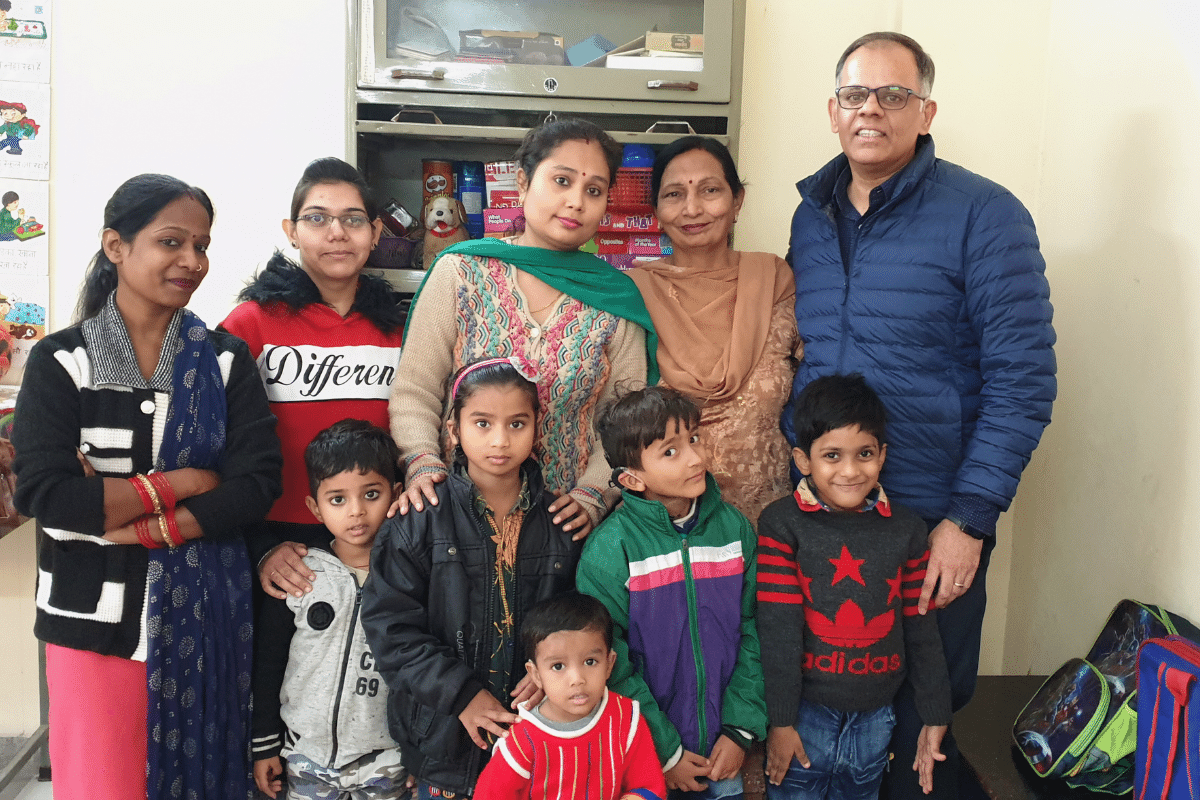For Children - NGO For Hearing Aid
NGO For Hearing Impaired
Suniye’s core competence depends on remedial education, where we offer targeted educational assistance to weaker students at our NGO for hearing aid to train them and help restore their engagement in the school. Furthermore, we, as a special school for hearing impaired, take a holistic approach by influencing the children through school climate, psychological wellness, extracurricular and sports activities.
NGO For Hearing Aid
We are proud of our children. We are in awe of their potential and what they can achieve. Our dream for each hearing impaired child is simple – we want them to grow up as confident members of society. At our NGO for hearing impaired school we want to equip them with speech and language therapy so that they are able to make decisions for their future and use their talents in doing well.
Among our children we have artists who make magic with the paintbrush. We have girls and boys who will dazzle you with their energy on the dance floor or leave you spell bound with the grace of their performance. We have skaters who have won many a race, coders who are valued members of their companies, people who have found their own start-up, others who have big plans of taking the family business to new heights.
Some of our children, now have families of their own and are showing the next generation the power and determination that brought them to the heights of personal and professional success. We have so many who serve as guiding lights to young hearing impaired children – showing them that with effort, nothing is impossible. To know more in Hindi, visit मूक-बधिर विद्यालय
Speech and Language Therapy Classes
It is very important to make sure that there is continuous learning fostered at home. Like all good habits, it is important to make sure that there are no breaks or gaps in the teaching. It might not be easy to extend the classroom environment all the time as the child may get bored and may not pay attention. This is true especially for younger children – the older children learn to manage themselves and do not need much personal attention. Here are some ideas of teaching aids by our educational NGO in Delhi school to help you create a continuous learning environment at home, especially if your hearing impaired child is still young. Contact us to know more Suniye’s speech therapy center in Delhi
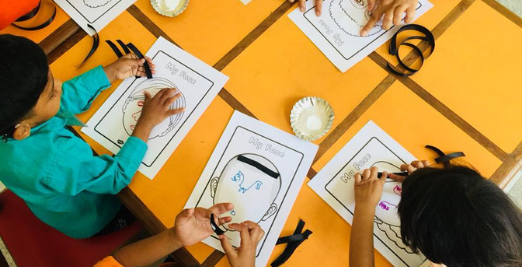
Frequently Asked Questions
Suniye’s aim is to provide relevant education to hearing impaired children, youth, and counselling services for their families and communities. We want to use the finest available methodology and technology to achieve optimum SROI (social return on investment), to practise and to combine corporate competitiveness with social development activities, and to raise awareness of Civic Powered Reform among the privileged.
Suniye has been working in the fields of speech and language therapy for hearing impaired children as well as providing counseling services and audiology lab services for the general public.
Education alone has the capacity to free people from poverty – not only in terms of earning a living, but also in terms of becoming aware of the rights and freedoms that citizens have. As a result, individuals are empowered and become self-sufficient.
Suniye was founded as a result of a group of corporate executives realising that it was their Social Responsibility to give back to society.
The target recipients of Suniye in the centre stage are children. The organisation believes that a child’s education cannot be achieved without addressing the needs of the chilren, particularly the parents, as well as the communities in which they live.
We are proud to say that in 2020-2021, we have conducted over 2,800 classes over WhatsApp Video, with many children having an almost 100% attendance record. We are looking at ways of improving the classes and look forward to enrolling more and more children, even those who are not residents of New Delhi.
Education alone has the capacity to free people from poverty – not only in terms of earning a living, but also in terms of becoming aware of the rights and freedoms that citizens have. As a result, individuals are empowered and become self-sufficient.
At Suniye, we use the classroom setting to assess the progress and plan the lessons for the next 7 days. This plan is managed between the classroom and the efforts of the parent at home. Suniye School is where the foundation for speech and language is built for the parents to develop on – which is why our teachers work with just 4 children each day.
At this stage we start with simple sounds like ‘aa’, ‘ee’, ‘oo’ etc. and gradually move towards simple words and then sentences. One must also keep in mind that it is important to repeat lessons again and again so that they are reinforced in the child’s mind. This is a slow process, and one needs to be patient, and not lose interest in case the child does not learn quickly. Teachers and parents must reward progress and attempts, and never scold or get angry if the child is playful and does not want to study.
Our trained teaching staff plan lesson plans for individual children basis their current speech and language and the hearing loss. Our classrooms are specially wired with FM technology so that the teacher’s speech is clearly picked up by the child’s hearing aid and there is no distortion. The teachers focus on gradually building speech and language and lip reading through many tools and techniques with regular reinforcement. After each week the progress is communicated to the parents and then the plan for the following week is built. We take advantage of the summer break and conduct classes so that there is no gap in the training of the children.
Teachers and parents should look at introducing games, storytelling, market, and other visits, as tools to teach. Remember every moment in the day is an opportunity to teach speck and languages. It is important to make even play time into a teaching opportunity – the more the child practices hearing sounds and speaking them out, the faster she or he will gain language.
During the lockdown, since children were unable to come to school, Suniye started conducting classes over WhatsApp Video Calls. While this is not ideal, it was the best option to ensure that the children did not lose out on their progress. We have seen parents and children adopt the e-classes with great enthusiasm and have been monitoring the progress through Google Forms that the teachers fill after each class.
We are proud to say that in 2020-2021, we have conducted over 2,800 classes over WhatsApp Video, with many children having an almost 100% attendance record. We are looking at ways of improving the classes and look forward to enrolling more and more children, even those who are not residents of New Delhi.
Talk, Talk, Talk
Make every moment an opportunity to speak to the child. Don’t do what many parents do and give the mobile phone with a YouTube video to keep the child quiet.
Remember, the more your child listens and tries to talk, the faster she or he will learn speech and language.With these children, there is no such thing as too much talking.
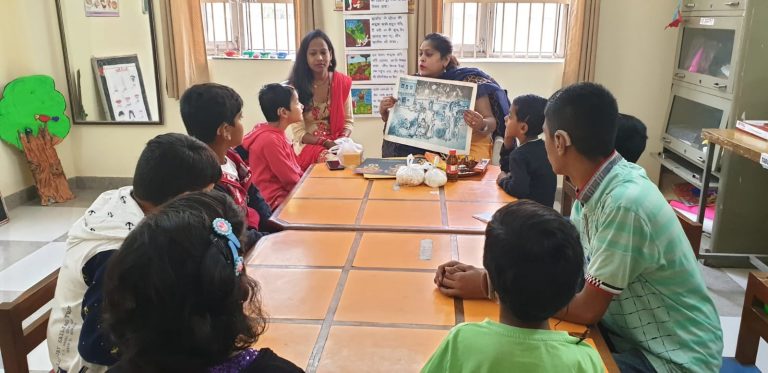
Ways to ‘Talk, Talk, Talk’
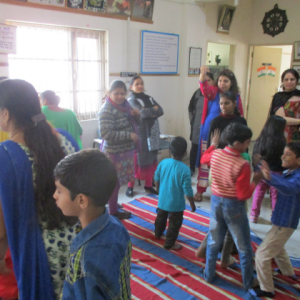
Select a photograph of the family from your previous visit and talk to your child about the family – how you know them, who all are the members etc. Talk about the last visit – what all happened, what you ate, what you wore, was it a special occasion? While it may seem difficult to do something like this, it becomes easier once you start. In fact, after a while your child will start to ask questions and make comments about the photo, maybe, something you haven’t noticed before. Likewise, you could also look at older photos of family members and go down memory lane.
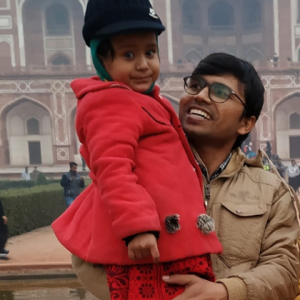
Open the family album and talk about all the places you have been, the various relatives, historical places. Talk about how much your child (and you) have grown. Remember the idea is to talk to the child as much as possible and make her or him talk too. Spend as much time on each photo, see if there are connections that can be made with other pictures – common people, places, dresses, colours etc. The family album is a great gateway to happy times. It also helps your child make connections beyond the immediate family – something that is important in the current times when travel is not possible.
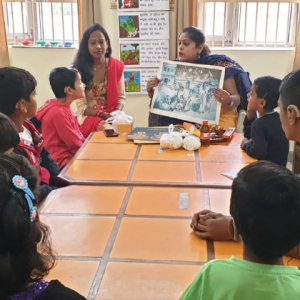
Pick up your child’s favourite story and read aloud. It is important that this exercise involve your child – ask her or him to explain details of the story. Try and see if they understand the plot or can grasp the moral of the story. Ask questions so that you are sure that they have understood the story well – to the point that they are able to explain it on their own. In case the story-book has pictures, discuss the colours and shapes seen. Ask your child what they liked about the story, or what they didn’t like. You will be surprised by their response – young children have a way of seeing things differently.
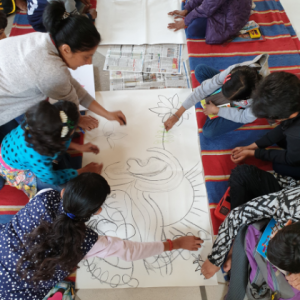
Pick up a blank sheet of paper, or better still a new page in a drawing book. Discuss what your child wants to draw, and why? Talk about the colours that are to be used to fill in various parts, ‘Is the parrot always green?’. Ask questions and challenge the child to be more creative. Art is a very good way to teach the child to be a creative thinker and become someone who thinks well outside the box. This is why it is important to go back to the drawings every now and then and talk about them. Your child might see things differently as they grow and might make new connections and build fresh ideas.

There is nothing better than music and dance in order to help children drop inhibitions and gain confidence. Singing and dancing are the first stage of being able to perform in a public, a necessity in work life. Start small. Let your child feel the beats through the floor or by touching the speaker. Alternately, they can watch a video and hear the sound through the hearing aids. Teach them the lyrics of the song, even just the chorus. Sing along with the video. If it is a movie, stop and explain what is happening on screen and play only after your child has understood.

For the overall development of your child’s speech, it is important that she or he interact with as many people as possible. Make sure that the child speaks to all those who love her or him – grandparents, aunts and uncles, siblings who are away, close family members, and friends. Use video calls so that the child can see the face of the person and learn to read lips in addition to hearing. The more people your child speaks to, the more people he learns to understand, and vice versa. Just remember to brief family and friends to speak normally and be a little patient, especially with young children.
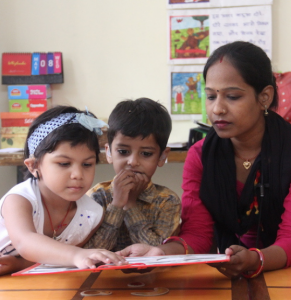
Cook, clean, iron clothes, wash…these are great opportunities for your child to learn a useful skill. More importantly, these activities are also opportunities for your child to listen and learn to hear and speak themselves. All these activities can be made fun thanks to the interaction with parents or siblings. These everyday jobs help the child become confident in taking care of their own things and feel the pride of a job well done. Imagine the joy if the Sunday breakfast has been made in partnership with your child or children? Or if the child learns to sort the bookshelf by author or colour?
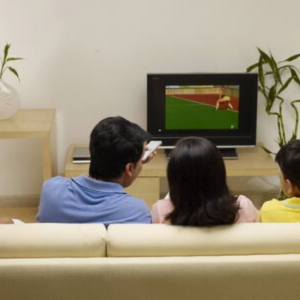 We often get lost in the action on the TV screen and forget that the television (or YouTube) is a great place to speak to your hearing impaired child. Make sure you watch programmes that are of interest to the child. Ask them questions, and answer what they ask. Dance with them, sing with them, let them learn the joy in music and dance. Talk about costumes and make-up, relationships, and feelings like love, anger, and sadness. Let them see as much of the world as they can and ignite their curiosity.
We often get lost in the action on the TV screen and forget that the television (or YouTube) is a great place to speak to your hearing impaired child. Make sure you watch programmes that are of interest to the child. Ask them questions, and answer what they ask. Dance with them, sing with them, let them learn the joy in music and dance. Talk about costumes and make-up, relationships, and feelings like love, anger, and sadness. Let them see as much of the world as they can and ignite their curiosity.
Teaching Aids & Ideas
It is very important to make sure that there is continuous learning fostered at home. Like all good habits, it is important to make sure that there are no breaks or gaps in the teaching. It might not be easy to extend the classroom environment all the time as the child will feel bored and not pay attention. This is true especially for younger children – the older children learn to manage themselves and do not need much personal attention. Here are some ideas and teaching aids to help you create a continuous learning environment at home, especially if your hearing impaired child is still young.
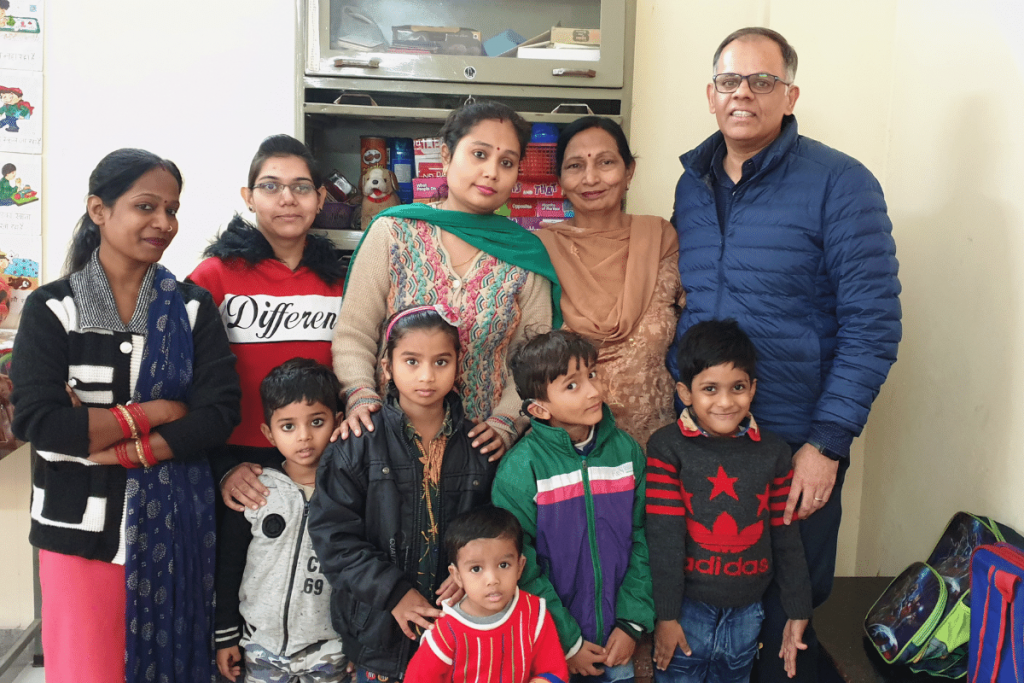
Here are some ideas of teaching aids by NGO for hearing aid school (Suniye)
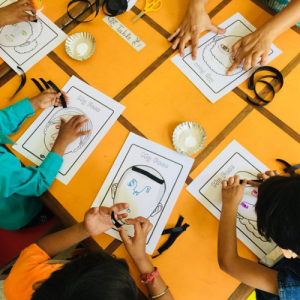
You need to ensure that the study area is a proper table with good lighting. It should be placed so that there are no disturbances because of ambient noise or distractions like the television. It is important that there should be adequate light on your face so that the child is able to clearly see your lips move, as also the study material. The chair should be at a comfortable height for the child to be able to write or draw. All the necessary study material – books, notebooks, pencils etc. should be nearby so that they can be easily picked up.
 Games where we need to count moves are great to teach numbers, addition, and subtraction. They are also useful in teaching concepts like ‘winning and losing’, ‘colours’ , ‘rules’ etc.
Games where we need to count moves are great to teach numbers, addition, and subtraction. They are also useful in teaching concepts like ‘winning and losing’, ‘colours’ , ‘rules’ etc.

Clocks are important tools to show and teach the idea of time and punctuality. It is important for children to learn how to tell time and hence understand the concept of ’24 hours’, ‘sixty minutes in an hour’, and ‘sixty seconds in a minute’. The calendar is a great way to explain the idea of dates, birthdates, festival dates, school days vs holidays, the summer and winter break…so many new ideas and reasons to talk. The calendar also helps teach counting – at least up to 30.
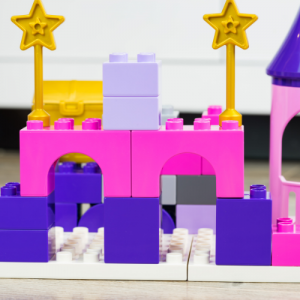 Building blocks are not just a fun way to keep children engaged and busy. They help them learn ideas like ‘colours’, ‘shapes’, and ‘sizes’. All this while improving their motor skills and learning how to make something exciting. Playing with blocks is always a fun time to speak to your child and get her or him to speak.
Building blocks are not just a fun way to keep children engaged and busy. They help them learn ideas like ‘colours’, ‘shapes’, and ‘sizes’. All this while improving their motor skills and learning how to make something exciting. Playing with blocks is always a fun time to speak to your child and get her or him to speak.
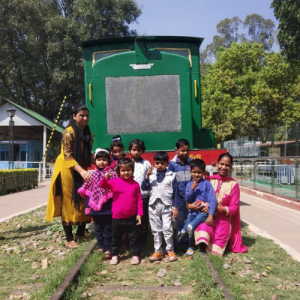
It is important to make learning fun by taking it out of the home. Take your child along when you go to the vegetable market or the shopping mall. Teach him about all the things she or he sees – the dresses people wear, the difference between tall and short or fat and thin, names of vegetables and fruits, flavours of the ice cream and so on. The same can be done at the zoo or a park or even the school itself.
 It is important to encourage creativity in hearing impaired children. Such activities help make learning fun, while making them interested in a useful talent. Who knows one of them might become a great artiste or dancer or sculptor? Art and origami are a nice and simple way of teaching so many things and giving them an opportunity to hear and gain language.
It is important to encourage creativity in hearing impaired children. Such activities help make learning fun, while making them interested in a useful talent. Who knows one of them might become a great artiste or dancer or sculptor? Art and origami are a nice and simple way of teaching so many things and giving them an opportunity to hear and gain language.
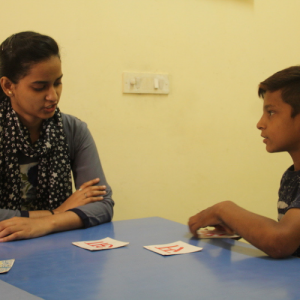 These charts are the best way to teach stories to the young girls and boys, they use simple words and frames and tell the full story. They also have words that explain the situation and the dialogue thus helping the child to understand simple words and learn reading. From these charts it is very easy to graduate to simple books and story videos.
These charts are the best way to teach stories to the young girls and boys, they use simple words and frames and tell the full story. They also have words that explain the situation and the dialogue thus helping the child to understand simple words and learn reading. From these charts it is very easy to graduate to simple books and story videos.
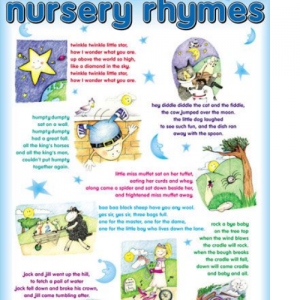
Singing and reciting rhymes are a great way to exercise the vocal cords and strengthen speech. They also help the child learn to express themselves well. Rhymes and songs are the way that many children gain vocabulary and the art of storytelling.
Hearing Aids
Taking care of hearing aids
It is critical that children learn to take care of their hearing aids from a very young age.
- Parents must teach them to test if the hearing aids are working properly or need to have the battery changed
- They should be able to identify if the hearing aid is working properly or not and ask a parent for help if needed
- It is important to ensure that the hearing aid is kept dust-free and dry so that it does not spoil or get damaged
- Children must know that they need to take care of these, just the way adults take care of their spectacles
- Your child should be taught to tell her or his friends not to touch or play with the hearing aids as they might damage them by mistake
- Likewise, children must also be taught to take care of their ears – The ears need to be kept dry and should be cleaned at least once a week with a soft ear bud
- One must ensure that the hearing aids are taken out and kept safely inside the box so that moisture does not get in
- Even the ear-moulds need to be periodically cleaned as ear-wax can block the passage and reduce the passage of sounds
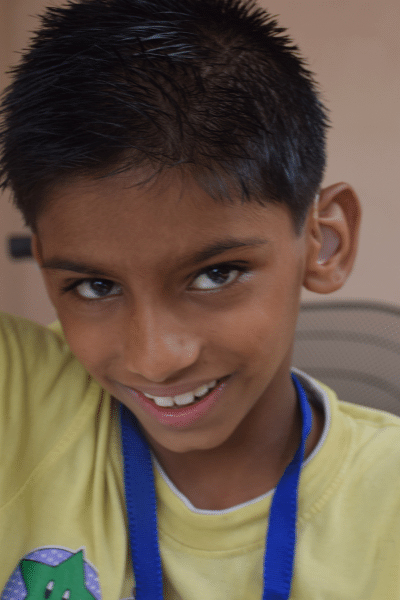
Join Suniye today! Let your child learn to hear and speak with us.

